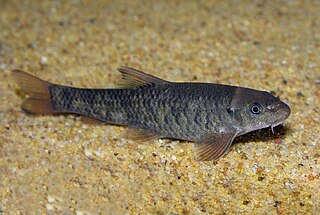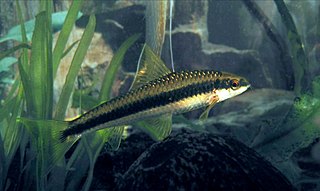
Cyprinidae is a family of freshwater fish, commonly called the carp or minnow family. It includes the carps, the true minnows, and relatives like the barbs and barbels. Cyprinidae is the largest and most diverse fish family and the largest vertebrate animal family in general, with about 3,000 species of which only 1,270 remain extant, divided into about 370 genera. Cyprinids range from about 12 mm in size to the 3-m giant barb. By genus and species count, the family makes up more than two-thirds of the ostariophysian order Cypriniformes. The family name is derived from the Greek word kyprînos.

Cypriniformes is an order of ray-finned fish, including the carps, minnows, loaches, and relatives. This order contains 11-12, although some authorities have designated as many as 23, families over 400 genera, and more than 4,250 species, with new species being described every few months or so, and new genera being recognized frequently. They are most diverse in southeastern Asia, and are entirely absent from Australia and South America. At 112 years old, the longest-lived cypriniform fish documented is the bigmouth buffalo.

Cobitidae, also known as the True loaches, is a family of Old World freshwater fish. They occur throughout Eurasia and in Morocco, and inhabit riverine ecosystems. Today, most "loaches" are placed in other families. The family includes about 260 described species. New species are being described regularly.

The members of the family Percichthyidae are known as the temperate perches. They belong to the order Perciformes, the perch-like fishes.

Phoxinus is a genus of freshwater fish in the family Leuciscidae of order Cypriniformes, and the only members of the subfamily Phoxininae, or Eurasian minnows. The type species is Phoxinus phoxinus. The other species in this genus are also commonly known as minnows. The name "minnow" was what early English fisherman used to describe "small and insignificant". The genus Phoxinus is found throughout Eurasia, and includes 21 known species. Previously, members of the North American genus Chrosomus were also believed to form part of this genus.

Garra is a genus of fish in the family Cyprinidae. These fish are one example of the "log suckers", sucker-mouthed barbs and other cyprinids commonly kept in aquaria to keep down algae. The doctor fish of Anatolia and the Middle East belongs in this genus. The majority of the more than 140 species of garras are native to Asia, but about one-fifth of the species are from Africa.
Danio erythromicron, often known as emerald dwarf danio and emerald dwarf rasbora, is a species of cyprinid fish which is endemic to Inle Lake in Myanmar.

The bitterling-like cyprinids form the cyprinid subfamily Acheilognathinae. This subfamily contains four genera, although the Khanka spiny bitterling is often placed in Acheilognathus, and at least 71 described species to date. Over half of the species are in the genus Acheilognathus.

Labeoninae is a doubtfully distinct subfamily of ray-finned fishes in the family Cyprinidae of order Cypriniformes. They inhabit fresh water and the largest species richness is in the region around southern China, but there are also species elsewhere in Asia, and some members of Garra and Labeo are from Africa. They are a generally very apomorphic group, perhaps the most "advanced" of the Cyprinidae. A common name for these fishes is labeonins or labeoins.

Hypselobarbus carnaticus, also known as the Carnatic carp, is a species of cyprinid fish from the Western Ghats in India where it inhabits riffles and larger pools in rapidly flowing rivers and streams. It prefers to shelter underneath boulders and overhangs. This species can reach a length of 60 centimetres (24 in) TL and has attained a maximum reported weight of 12 kilograms (26 lb). It is a commercially important fish and is also farmed.

Hypselobarbus is a genus of fish in the family Cyprinidae endemic to India.

Leuciscinae is a subfamily of the freshwater fish family Cyprinidae, which contains the true minnows. Members of this subfamily are known as European minnows or the Old World (OW) clade of minnows. As the name suggests, most members of this family are found in Eurasia, aside from the golden shiner, which is found in eastern North America.

Loaches are fish of the superfamily Cobitoidea. They are freshwater, benthic (bottom-dwelling) fish found in rivers and creeks throughout Eurasia and northern Africa. Loaches are among the most diverse groups of fish; the 1249 known species of Cobitoidea comprise about 107 genera divided among 9 families.

The danionins are a group of small minnow-type fish belonging to the family Cyprinidae. Members of this group are mostly in the genera Danio, Devario and Rasbora. They are primarily native to the fresh waters of South and Southeast Asia, with fewer species in Africa. Many species are brightly coloured and are available as aquarium fish worldwide. Danio species tend to have horizontal stripes, rows of spots, or vertical bars, and often have long barbels. Devario species tend to have vertical or horizontal bars, and short rudimentary barbels, if barbels are present at all. All danionins are egg scatterers and breed in the rainy season in the wild. They are carnivores living on insects and small crustaceans.

Gobioninae is a monophyletic subfamily of Eurasian cyprinid fishes. A species-rich subfamily, it is divided into five tribes: Gobionini, Pseudogobionini, Hemibarbini, Coreiini, and Sarcocheilichthyini.

The Tokyo bitterling is a temperate freshwater fish of the carp family (Cyprinidae). Taxonomically, it belongs to the subfamily Acheilognathinae.

Haemulinae is a subfamily of the Haemulidae and consists of the genera of that family which are regarded as being of New World origin, although they are now widespread. The subfamily is distinguished from the Plectorhynchinae by having a short dorsal fin which contains 13-16 soft rays, as opposed to the long dorsal fin with 17-26 soft rays of the subfamily Plectorhynchinae.

Plectorhinchinae, is one of two subfamilies of the family Haemulidae, some known colloquially as sweetlips. This subfamily is regarded as having an Old World origin.

Alburninae is a small subfamily of the carp and minnow family of ray-finned fish, the Cyprinidae. The genera in this subfamily were previously considered to be part of the Leuciscinae,but if the three Alburninae genera are included in that subfamily, it is paraphyletic. The Alburninae are still a contentious group and some authorities consider it to consist of two distinct clades, making it biphyletic.

Xenocyprinae, is a contentious subfamily of the family Cyprinidae, the carp and minnow family, originally from eastern Asia.






















